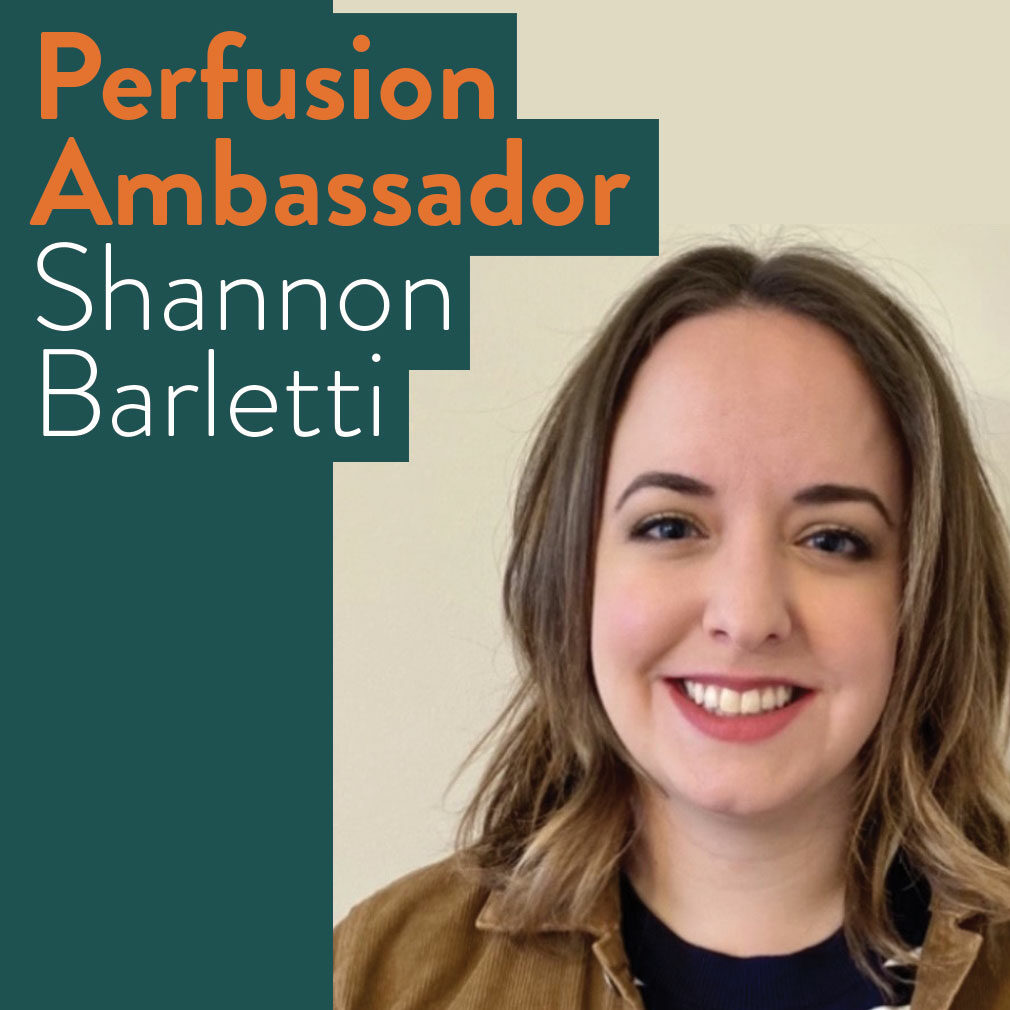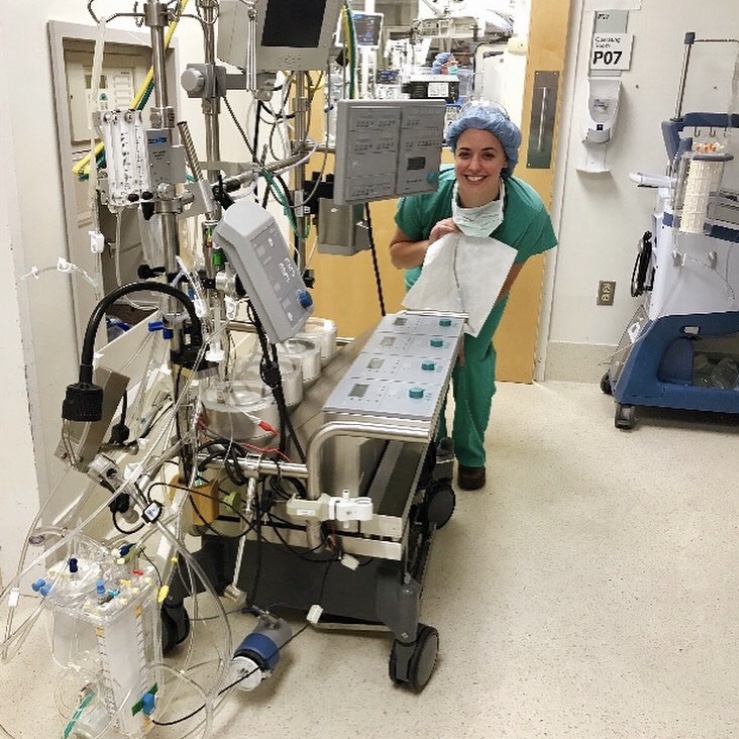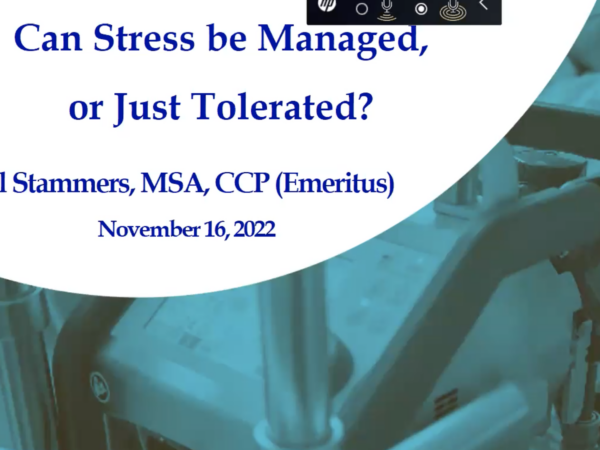
How Long Have You Been a Perfusionist?
I’ve been a perfusionist for about a year and a half. I’m currently working with SpecialtyCare at Thomas Jefferson University Hospital in Philadelphia, Pennsylvania.
What Led You to Become a Perfusionist?
Before I became a perfusionist, I worked in nursing for ten years. When I started to train to care for immediate post-operative cardiac surgery patients in the CVICU, which was my ultimate goal and a dream of mine since graduating from nursing school, we had to shadow a cardiac case in the operating room. That was when I first saw the heart-lung machine and really witnessed exactly what a perfusionist does. I was blown away.
For a few years after that, I worked in the CVICU. I took closer notice of the different things that perfusionists did in the unit. I took care of an ECMO patient, which was a rare occurrence at the hospital I was working at. From there, I was hooked. I had to shadow again and start looking into perfusion programs. At the time, the only perfusion program in my area was closing, and there wasn’t another one in my area. I wasn’t in a place with my personal responsibilities to quit my job and move across the country for schooling, but I always had it in the back of my mind.
When Thomas Jefferson University started its perfusion program, I knew I had to apply. I began saving and planning, to be able to confidently step down from my full-time nursing position and attend perfusion school full-time. That process took almost three years. It was a giant leap of faith and pretty scary before and during because I’d always worked full-time through all college-level certificates and degrees. However, I believe that I had the best experience possible and got the most out of my perfusion education and clinicals because I was able to fully dedicate myself to learning as much as I could about this new profession.
What are the Benefits of a Career in Perfusion?
A career in perfusion is unique and has many benefits. You work as part of a team to help improve or even save the lives of others. It can be pretty challenging, but it’s ultimately very fulfilling and rewarding as you are genuinely helping to make a difference. Perfusionists are in high demand. As a result, there are many job opportunities right now.
I believe this demand will continue as healthcare evolves, especially in advanced heart failure therapies and ECMO use. Perfusionists are needed for various duties, which makes the job exciting and different depending on where and what role you choose to work. Having this flexibility and variability is a great benefit.

What is a Day in the Life of a Perfusionist Like?
No two days in the life of a perfusionist are the same. That’s what I like most about being a perfusionist. One day you might do a complicated 12-hour case in the OR that requires you to think outside of the box and collaborate very closely with the OR team. Whereas, the next day, you might fly out on a helicopter or ride in an ambulance to pick up a critically ill ECMO patient. The day after that, you might work with the ICU team to care for an ECMO patient at his bedside, or maybe it’s your call day and you rested in the morning so you can work with the heart transplant team overnight. A career in perfusion can be exciting!
What is Something You Wish all Perfusionists Knew to Prepare Themselves for Before Starting Their Careers?
Perfusion isn’t your average job. It’s a career and a lifestyle. It’s not a 9-5 job. The varying schedule, hours, and responsibilities require adjusting for new perfusionists and their family and friends. Suppose you’ve never experienced being on-call before. It’s manageable with some practice, but support, flexibility, and understanding from your familial and social networks are necessary to maintain a happy work-life balance.
Even after taking the call as a nurse, I think this was a significant shift in perfusion. It took a while for me to adapt, but taking student calls helped better prepare me for this when I started as a full-time perfusionist. It gave me a chance to practice trying out different ways to best manage without the additional stressors of being the primary perfusionist.
How Does a Perfusionist Contribute to the Well-Being of the Patient?
The perfusionist is essential to the patient’s well-being because they are caring for them during their most vulnerable times. Whether the patient is in the operating room requiring cardiopulmonary bypass, the ICU on ECMO, being transported with a cardiac mechanical assist device, or needing a cell saver for another procedure—the perfusionist is there. Perfusionists help to support the patient’s vitals, homeostasis, acid-base balance, and protect the patient’s brain and vital organs with the cardiopulmonary bypass machine and ECMO during surgery, or as a bridge to recovery from certain illnesses. Perfusionists help to ensure that the patient has the best outcome possible.
How Does a Perfusionist Change the Dynamic of the OR?
A perfusionist changes the dynamic of the OR just like having or not having a shortstop would change the dynamic of a baseball team. Every individual is vital to their team, especially in maintaining the dynamic. What’s most interesting is that in the OR, the bulk of responsibility shifts from one part of the team to another during different times of the operation. As a result, the team is able to back each other up—much like a second base player and a shortstop—alternating who is primarily responsible and who is supporting at that time.
For example, the perfusionist has already completed their set up and checklists when the patient has entered the room while the nursing and anesthesia teams are busy preparing the patient for surgery. During this time, the perfusionist acts as a support and an extra set of eyes and ears to help the team and ensure patient safety and quality care. Once the operation is underway and it’s time for cardiopulmonary bypass, the perfusionist assumes a large amount of responsibility from the anesthesia team where they begin to support the perfusionist who is now primarily managing the patient’s vitals and homeostasis.
Once the cardiopulmonary bypass is completed, the dynamic shifts again and the perfusionist becomes the supportive team member. This occurs less with perfusionists than other team members throughout the operation. On the best teams, this dynamic is seamless with each team member understanding what their roles and responsibilities are and helping in whatever ways they can.

What Advice Do You Have for Upcoming Perfusionists?
Situational awareness is imperative in the operating room. I believe it’s important to invest time in watching the team as a respectful observer. Notice each person’s role, the times during the operation when there is a heightened level of awareness, increased stress levels, when greater attention to detail is needed, and how the team interacts with one another.
Each team has a unique culture that allows them to interact seamlessly, picking up where the other left off without a hitch to make surgery, ECMO, and excellent patient care possible. Joining the team and learning this culture from a place of great respect will help make the orientation process smoother and help you to assimilate faster.
What is One Way a Perfusionist Can Set Himself/Herself up for Greatness?
A positive attitude and a strong work ethic are a dynamic duo that is almost necessary to ensure success in any career, especially perfusion. You can never be too prepared as a perfusionist. Coming in early, staying late, or going the extra mile during downtime to ensure that you’re well prepared for any and every situation that can occur will help yield personal and team success. Preparedness will also help to lower your stress levels and enable you to be more present and effective in any challenging or emergent situation that might arise. During my first year as a perfusionist, I found that having everything ready and thinking two steps ahead helped me to become a better perfusionist.
What is a Resource You Enjoy and Trust on the Profession?
Cardiopulmonary Bypass by Sunit Ghosh, Florian Falter, and Albert C. Perrino, Jr. was a required text in my program. It has a lot of really useful information, but it’s nicely summarized and easy to read. I found myself carrying it around as my “go-to” resource, along with The Manual of Clinical Perfusion, during school and in my first few months as a perfusionist.
The American Society of Extracorporeal Technology’s (AmSECT) website is a great resource for me. Their perfusion clinical resources, Journal of Extracorporeal Technology and AmSECT Today, offer a lot of current, pertinent, and interesting content to keep me up-to-date with evidence-based practices and happenings in perfusion.
What Has Been a Memorable Moment From Your Career?
Starting a career in perfusion at the start of a global pandemic has been quite an experience and one that I’ll never forget. The hospital setting, a place that has felt like a second home to me for over a decade, and healthcare changed entirely almost overnight. COVID-19 affected our ICUs, ORs, staffing, resources, and patient management on a scale that I never thought possible.
Managing the surge of ECMO, learning how to care for these patients with unique complications and coagulopathies, and trying to get my feet wet in this new profession was challenging. One of the most memorable events was flying out with the helicopter team to place a very young patient on ECMO and bring them back to our hospital to continue care. During the flight back with the patient on ECMO, it hit me just how significant of a responsibility it is to be a perfusionist.





Comments are closed.